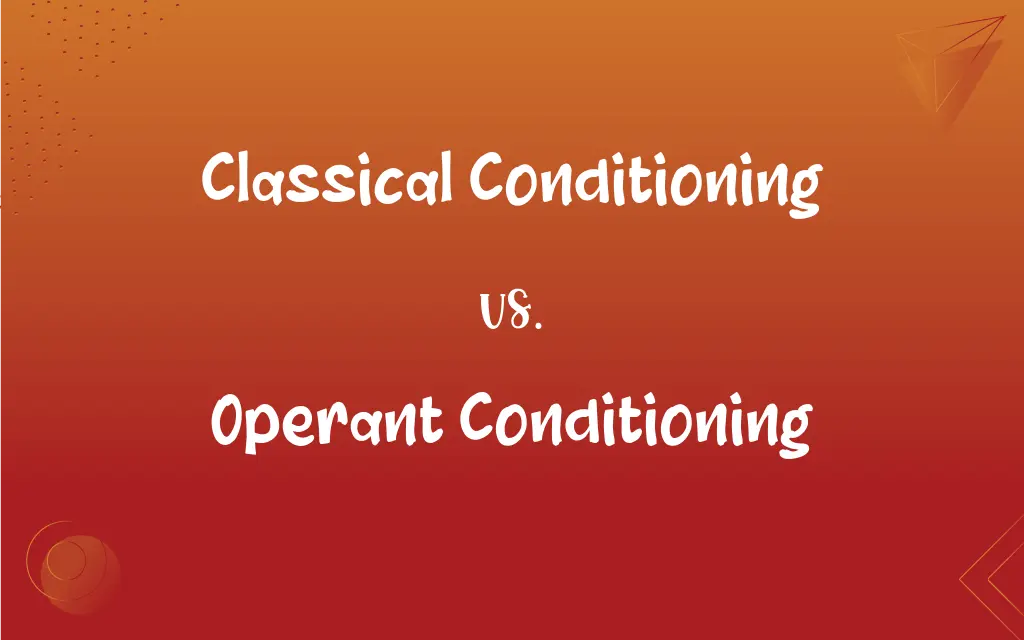Classical Conditioning vs. Operant Conditioning: What's the Difference?
Edited by Harlon Moss || By Janet White || Published on November 19, 2023
"Classical Conditioning" is learning through association between stimuli, while "Operant Conditioning" is learning based on rewards and punishments following behaviors.

Key Differences
"Classical Conditioning" is a process where a neutral stimulus becomes associated with a meaningful stimulus, leading to a similar response. In contrast, "Operant Conditioning" involves learning where behaviors are strengthened or weakened depending on consequences that follow them.
In "Classical Conditioning," a once-neutral stimulus elicits a response after being paired repeatedly with another stimulus that naturally produces that response. "Operant Conditioning," on the other hand, revolves around reinforcement or punishment, guiding behavior towards desired outcomes or away from undesirable ones.
"Classical Conditioning" was famously demonstrated by Ivan Pavlov with his experiments on dogs, showcasing how a ringing bell (neutral stimulus) could make dogs salivate when paired with food. In "Operant Conditioning," B.F. Skinner emphasized the role of rewards and punishments in shaping behavior, using tools like the Skinner box to demonstrate this with rats.
While "Classical Conditioning" deals mainly with involuntary responses like reflexes, "Operant Conditioning" focuses on voluntary behaviors and their consequences. Both play a significant role in shaping behavior, yet they operate through distinct mechanisms and principles.
Comparison Chart
Type of Behavior
Involuntary (reflexive) behavior.
Voluntary behavior.
ADVERTISEMENT
Basis
Association between stimuli.
Consequences following a behavior.
Key Figures
Ivan Pavlov.
B.F. Skinner.
Reinforcement/Punishment
Not directly applied.
Central components to modify behavior.
Examples
Salivating at the sound of a bell.
A rat pressing a lever for food or avoiding it for a shock.
Classical Conditioning and Operant Conditioning Definitions
Classical Conditioning
Learning by pairing a neutral stimulus with a significant one.
After hearing a loud noise when seeing a balloon pop, a child might cry just at the sight of a balloon due to Classical Conditioning.
ADVERTISEMENT
Operant Conditioning
Behavioral learning method using rewards and punishments.
Training a bird to perform tricks for treats is an example of Operant Conditioning.
Classical Conditioning
Associative learning where a stimulus gains the power to evoke a response.
Through Classical Conditioning, a dog can be trained to sit upon hearing a specific sound.
Operant Conditioning
Learning where behavior is shaped by its consequences.
Children might complete chores when rewarded with an allowance, a form of Operant Conditioning.
Classical Conditioning
Learning where a previously irrelevant stimulus triggers a reflexive response.
Through Classical Conditioning, a scent can evoke strong memories and feelings from the past.
Operant Conditioning
Modification of behavior through reinforcement or punishment.
By using Operant Conditioning, teachers can manage classroom behavior using a system of rewards and consequences.
Classical Conditioning
A process where two stimuli become linked, causing a response.
Pavlov's experiments highlighted how Classical Conditioning could make a bell sound induce salivation in dogs.
Operant Conditioning
Learning process where the likelihood of a behavior is increased or decreased based on outcomes.
A cat might avoid a couch it was previously sprayed with water on, an example of Operant Conditioning.
Classical Conditioning
Conditioning where a neutral stimulus elicits a response after association.
Classical Conditioning explains why some songs might make us feel emotional, associating them with past memories.
Operant Conditioning
Conditioning that associates a voluntary behavior with its consequence.
Operant Conditioning techniques are used in dog training, rewarding good behavior and discouraging the undesirable.
FAQs
What's the foundational concept of "Classical Conditioning"?
"Classical Conditioning" revolves around learning through association between two stimuli.
Who's the main figure behind "Classical Conditioning"?
Ivan Pavlov is most commonly associated with "Classical Conditioning" due to his experiments with dogs.
What's a primary tool associated with "Operant Conditioning" studies?
The Skinner box, developed by B.F. Skinner, is a primary tool in "Operant Conditioning" research.
Is positive reinforcement a component of "Operant Conditioning"?
Absolutely, positive reinforcement is a key concept in "Operant Conditioning," where desired behaviors are rewarded.
Is timeout a technique from "Operant Conditioning"?
Yes, timeout is a form of negative punishment in "Operant Conditioning."
Are reflexes related to "Classical Conditioning"?
Yes, "Classical Conditioning" often involves reflexive behaviors triggered by paired stimuli.
Can "Classical Conditioning" influence phobias?
Yes, phobias can be understood as a result of "Classical Conditioning," where a neutral stimulus becomes feared through association.
How does "Operant Conditioning" handle non-reinforced behavior?
In "Operant Conditioning," when behavior isn't reinforced, it will eventually undergo extinction, decreasing in frequency.
Does "Classical Conditioning" require consciousness?
No, "Classical Conditioning" can occur without the subject being consciously aware of the association.
Can "Classical Conditioning" be unlearned?
Yes, through a process called extinction, the response in "Classical Conditioning" can diminish over time without reinforcement.
How does "Operant Conditioning" shape behavior?
"Operant Conditioning" shapes behavior through rewards (reinforcements) for desired actions and punishments for undesired actions.
What's the main goal of "Operant Conditioning" in training?
The main goal of "Operant Conditioning" is to increase desired behaviors and decrease undesired ones using consequences.
Can "Operant Conditioning" be applied in classrooms?
Yes, "Operant Conditioning" principles like rewards and consequences are often used in educational settings to manage behavior.
Can humans be subjects of "Classical Conditioning"?
Absolutely, humans can learn associations through "Classical Conditioning" just as other animals can.
How does timing impact "Classical Conditioning"?
Timing is crucial in "Classical Conditioning"; the neutral stimulus must consistently precede the unconditioned stimulus for effective pairing.
What role does shaping play in "Operant Conditioning"?
In "Operant Conditioning," shaping is a technique where successive approximations of a behavior are rewarded until the desired behavior is achieved.
Are schedules of reinforcement part of "Operant Conditioning"?
Yes, "Operant Conditioning" often uses various reinforcement schedules (like fixed or variable) to determine the pattern of rewards.
What's a conditioned stimulus in "Classical Conditioning"?
In "Classical Conditioning," a conditioned stimulus is a previously neutral stimulus that, after pairing, elicits a response.
Is "Classical Conditioning" limited to a specific type of behavior?
"Classical Conditioning" is often associated with involuntary, reflexive behaviors.
How does negative reinforcement differ in "Operant Conditioning"?
In "Operant Conditioning," negative reinforcement strengthens behavior by removing an aversive stimulus.
About Author
Written by
Janet WhiteJanet White has been an esteemed writer and blogger for Difference Wiki. Holding a Master's degree in Science and Medical Journalism from the prestigious Boston University, she has consistently demonstrated her expertise and passion for her field. When she's not immersed in her work, Janet relishes her time exercising, delving into a good book, and cherishing moments with friends and family.
Edited by
Harlon MossHarlon is a seasoned quality moderator and accomplished content writer for Difference Wiki. An alumnus of the prestigious University of California, he earned his degree in Computer Science. Leveraging his academic background, Harlon brings a meticulous and informed perspective to his work, ensuring content accuracy and excellence.






































































